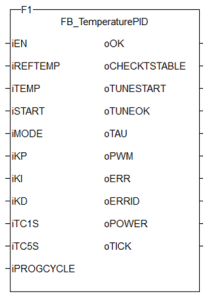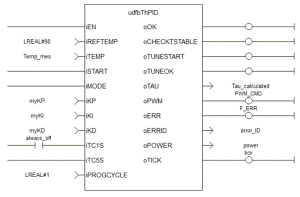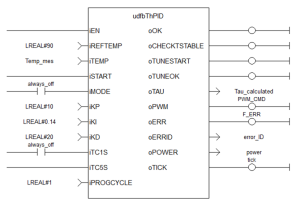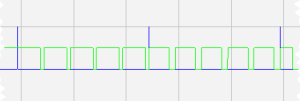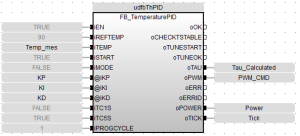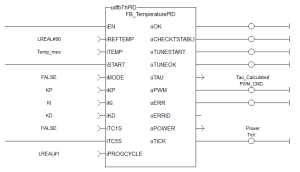FB_TemperaturePID
 Function Block
Function Block![]() A function block groups an algorithm and a set of private data. It has inputs and outputs. - Provides PID
A function block groups an algorithm and a set of private data. It has inputs and outputs. - Provides PID![]() "Proportional-Integral-Derivative"
A PID controller is a generic control-loop feedback mechanism widely used in industrial control systems.
An "error" occurs when an event or a disturbance triggers off a change in the process variable.
A PID controller attempts to correct the error between a measured process variable and a desired setpoint by calculating and then outputting a corrective action that can adjust the process accordingly temperature control with auto tuning.
"Proportional-Integral-Derivative"
A PID controller is a generic control-loop feedback mechanism widely used in industrial control systems.
An "error" occurs when an event or a disturbance triggers off a change in the process variable.
A PID controller attempts to correct the error between a measured process variable and a desired setpoint by calculating and then outputting a corrective action that can adjust the process accordingly temperature control with auto tuning.
Inputs
|
Input |
Data Type |
Range |
Unit |
Default |
Description |
|---|---|---|---|---|---|
|
iEN |
BOOL |
|
|
|
Enable function. |
|
iREFTEMP |
LREAL |
|
|
|
Reference temperature [°C]. |
|
iTEMP |
LREAL |
|
|
|
Actual temperature [°C]. |
|
iSTART |
BOOL |
|
|
|
Start PID or auto tuning. |
|
iMODE |
BOOL |
|
|
|
|
|
iKP |
LREAL |
|
|
|
PID Proportional Gain. |
|
iKI |
LREAL |
|
|
|
PID Integral Gain. |
|
iKD |
LREAL |
|
|
|
PID Derivative Gain. |
|
iTC1S |
BOOL |
|
|
|
Sampling Time is 1s. |
|
iTC5S |
BOOL |
|
|
|
Sampling Time is 5s. |
|
iPROGCYCLE |
LREAL |
|
|
|
Execution time of the function [ms]. |
Outputs
|
Output |
Data Type |
Range |
Unit |
Description |
|---|---|---|---|---|
|
oOK |
BOOL |
|
|
|
|
oCHECKSTABLE |
BOOL |
|
|
TRUE when checking if ambient temperature is stable. |
|
oTUNESTART |
BOOL |
|
|
Tuning is started. |
|
oTUNEOK |
BOOL |
|
|
Tuning is completed. |
|
oTAU |
LREAL |
|
|
System Time Constants. |
|
oPWM |
BOOL |
|
|
PWM command for heater. |
|
oERR |
BOOL |
|
|
Function error. |
|
oERRID |
INT |
|
|
Function ID error (in case of oERR=TRUE). |
|
oPOWER |
LREAL |
|
|
% of power requested from heater (100%=full power). |
|
oTICK |
BOOL |
|
|
Pulse |
Remarks
Figure 6-111: FB_TemperaturePID
Usage
Tuning Process
Tuning consists of three steps.
- Verify the ambient temperature is stable.
The measured delta_temp=Tmax-Tmin must be lower than 0.1*Tmax.
This step takes 10 cycles (10*iTC5s or 10*iTC1s).
The tuning fails (oERR=TRUE, oERRID=1) if the ambient temperature is greater than 0.1*Tmax, otherwise Tamb=(Tmax+Tmin)/2. - Start tuning Phase1: output oPWM is kept TRUE until the final measured temperature iTEMP gets over iREFTEMP/2.
After that, oPWM is kept LOW. - Start tuning Phase2.
With oPWM kept LOW, the temperature gets down until the final value is lower than [(iREFTEMP/2-Tamb)*0.368+Tamb].
After, PID gains are calculated as:
Kp=10
Ki=0.14
delta_time = time to complete Phase2 Kd=SQRT(delta_time)*7
The tuning is completed.
-
-
oTAU may be useful for setting the proper sampling time (1s or 5s).
Start PID Controller
- When starting the PID controller:
- The output oPWM is modulated five times within the sampling time (blue line is oTICK, green line is oPWM).
- Each pulse length depends on output oPOWER (100%=full length).
FBD Language Example
FFLD Language Example
IL Language Example
Not available.
ST Language Example
//Run PID function with determined proportional, integral, and derivative gains
//send PWM output to command heater
udfbThPID( TRUE, 90, Temp_mes, TRUE, FALSE, KP, KI, KD, FALSE, TRUE, 1);
Tau_Calculated := udfbThPID.oTAU;
PWM_CMD := udfbThPID.oPWM;
Power := udfbThPID.oPOWER;
Tick := udfbThPID.oTICK;
